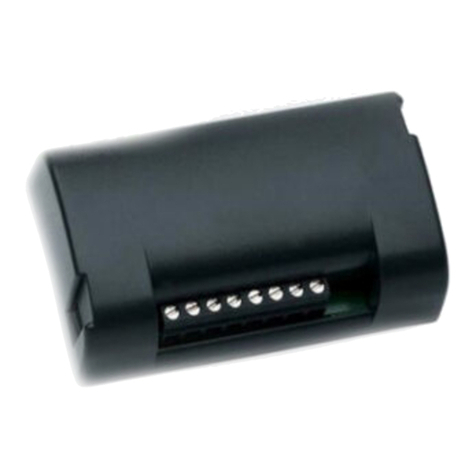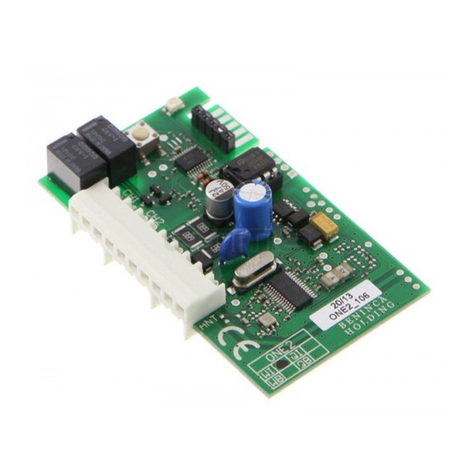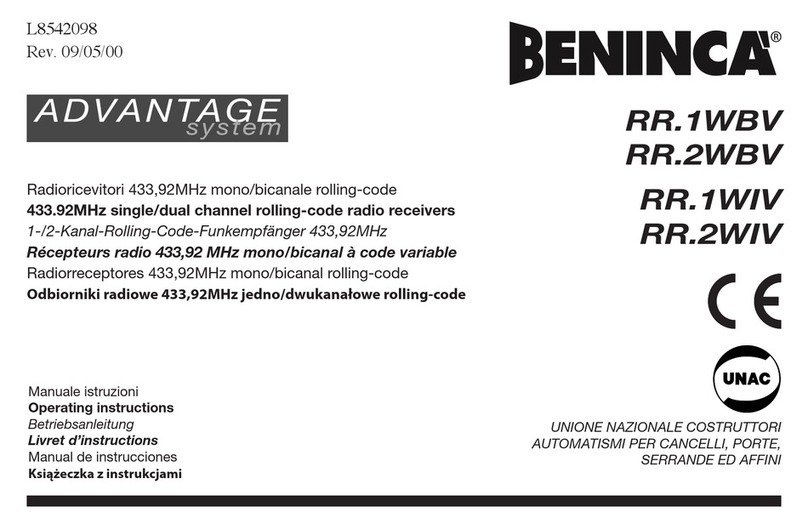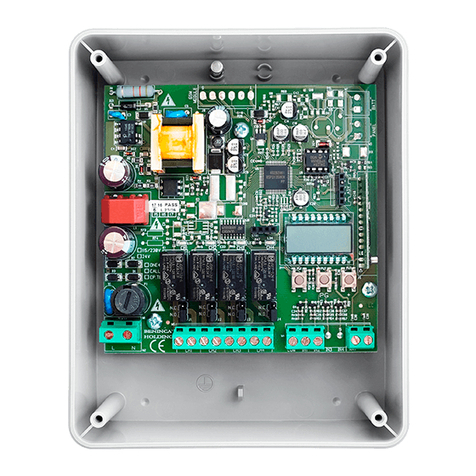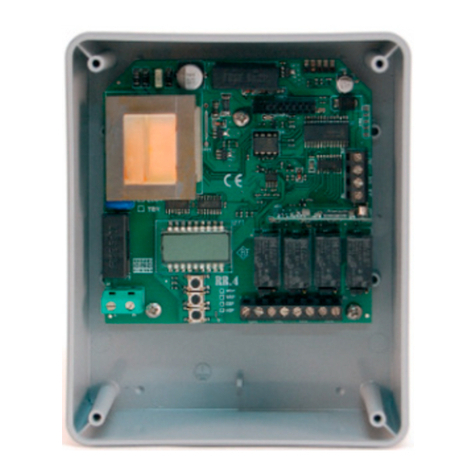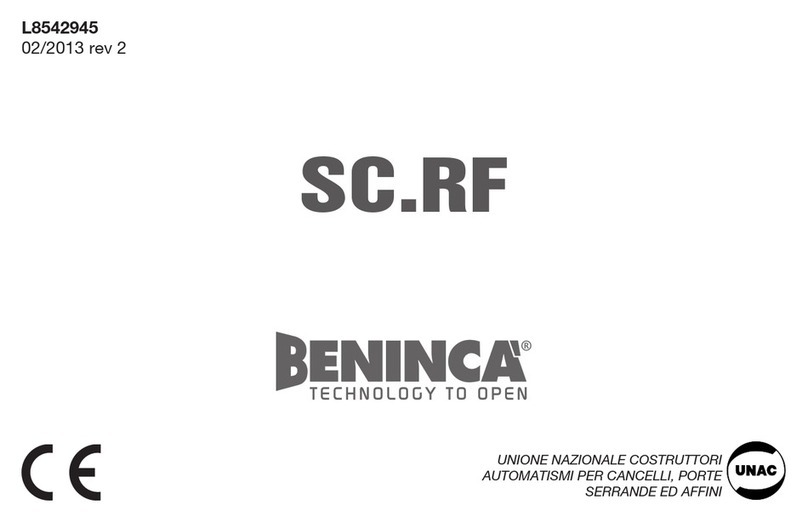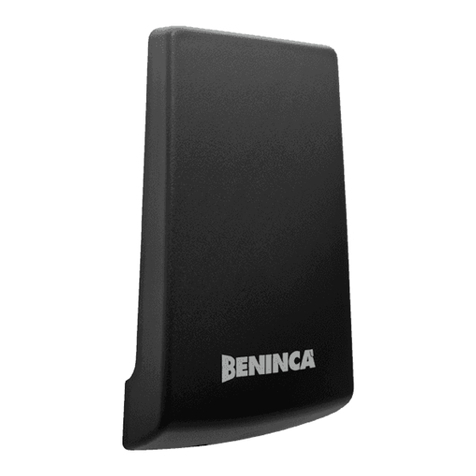
Description
The receivers of the series LO.R1 …. CV and LO.R2 …. CV are radio units which allow the remote activation of any
device. Three different models are available: saw, super-reactive and quartz, with variable code digital coding. This
coding offers 18 billion billions of combinations thus ensuring safety, protection from interference and no undesired
activation.The transmitter-receiver system features the management of 1 channel (LO.R1…CV) or 2 channels (LO.R2
…CV).With one single receiver, complete with memory module LO.M3, up to 1000 transmitter codes can be stored in
memory. According to the transmitter configuration, each channel can operate in three different modes: Immediate,
Step-by-step and Time-based.
How to memorize the code of a transmitter
1 Power the receiver to terminals 5 and 6, as indicated in figure 3.
2 To activate the learning mode, three different procedures can be carried out:
a Press the self-learning key for a short time.
b Press the hidden key of a transmitter already stored in memory.
c Press a key of memory opening on the transmitter.
Some of these procedures can be disabled by using a programmer LO.PROG or LO.PM.In any case, the red LED 1
switches on.
3 Press the key of the transmitter to be stored in memory until the LED 1 starts flashing. After 2 flashes, the LED
switches off. The key of the transmitter which is pressed first will be memorized on the first channel of the receiver
(relay 1).
4 The receivers of the series LO.R1 and LO.R2 allow another type of learning of transmitter codes, i.e. through the
function which memorizes the code created by pressing two keys on the same unit.To carry out this function, proceed
as follows:
a: Use a transmitter with 2 or 4 keys
b: Press 2 keys of the transmitter simultaneously (ex.A and B, see Fig.1).The keys pressed are considered as a
single key by the receiver.The code is stored in memory in the first channel free in the receiver (ex.A+B >>1st
channel).
c: At this point, carry out the learning of the remaining keys of the transmitters to be stored in memory, by follow-
ing the desired sequence: press, and then store in memory one key at a time (ex. A or B or C or D).
It is necessary to keep in mind that the first key of the transmitter which is pressed, or the first combination of keys
performed, will be matched to the first channel of the receiver. The second key pressed is matched to the second
channel of the receiver itself (only LO.R2).
The code resulting from the combination of two keys can be memorized also in a single-channel receiver (LO.R1).
5 Repeat the sequence of operations from point 2 to point 4 for all the transmitter codes to be stored in memory.
How to memorize the codes of more than one transmitters (multiple learning)
1 Power the card to terminals 5 and 6 of the receiver.
2 Press the self-learning key for 3 seconds, then release the key.The LED 1 of the receiver indicates that the unit has
entered the multiple learning mode by flashing twice, and then the lights remains steady.
3 Press the key of each transmitter (Fig.1) the code of which is to be memorized;e.g.in the sequence A,B, the first key
which is pressed (in this case A), will be stored in memory in the first channel of the receiver.The second code (in this
case B) will be matched to the second channel in the receiver.The LED 1 of the device flashes twice to indicate that
the code has been correctly stored.
4 By pressing, in the desired sequence, the keys of the remaining transmitters to be stored, the relevant codes are
learned.
5 By pressing the receiver key, the multiple learning phase is terminated: the LED switches off.
During storage, the receiver waits the code to be learned for about 20 seconds.If no signal is received during this time,
the receiver returns to the normal operating mode.
N.B.: If, in the storing phase, LED 1 does not flash, the code has not been memorized.
In this case, carry out the following checks:
•The transmitter should have the same frequency as the receiver.This case can be checked through the LED 2 of radio
diagnosis, which should switch on when the transmitter key is pressed.
•The transmitter code has already been stored in memory: press the key by checking to which channel it corresponds.
•The memory is full: in this case the maximum number of codes has already been stored in memory. This condition
may be checked by reading the memory with the programmer LO.PROG or LO.PM.
How to erase all codes
1 Cut off power supply to the receiver card.
2 Keep the self-learning key pressed and switch the receiver on again. After about 3 seconds the LED 1 switches on.
3 Release the receiver key.
4 Wait until the LED 1 is switched off.When the LED switches off, all codes will be erased.
LO.R1-2W/L/ECV PIC
Radio receivers, SAW card, super-reactive and quartz with variable code
